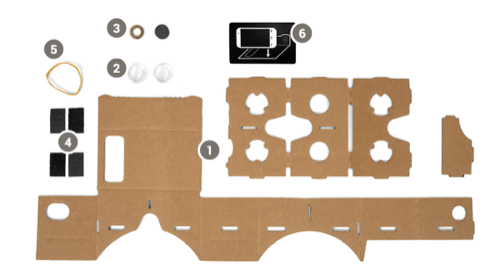Google doled out free smartwatches running Android Wear at its I/O 2014 developer event today, but that’s not all. The company also handed out … cardboard. Yes, really.
Google encouraged a room full of thousands of developers and hundreds of press-types to take little sheets of cardboard and fold them into kind of nifty (if thrifty) virtual reality viewers. Unlike the pricier bits of I/O swag, those at home can play along too.

Assuming you weren’t lucky enough to get a cardboard kit at I/O, to build one of Google’s low-tech VR goggles you’ll need materials that would be at home in a MacGyver scene. Start with cardboard ($8.70 … or a pizza box?), biconvex lenses ($28) and magnets ($3.98, $2.59), then add Velcro ($2.98), a rubber band (free!) and an optional NFC tag ($1.50). That’s a grand total of about $50 worth of stuff ($47.75, to be exact), assuming you don’t have it all laying around the house.
Of course, you’ll need a compatible new-ish Android smartphone, too.

For developers interested in building virtual reality experiences that aren’t cost prohibitive, Google’s Cardboard project (that’s actually the name for it) comes with its very own “experimental” VR software development kit. Aside from the Nexus Q, Cardboard might be the weirdest pseudo-product that the company has ever launched, though its goals are arguably nobler than that entertainment bowling ball of yore
In a blog post about the project, Google explains its intentions:
Virtual reality has made exciting progress over the past several years. However, developing for VR still requires expensive, specialized hardware. Thinking about how to make VR accessible to more people, a group of VR enthusiasts at Google experimented with using a smartphone to drive VR experiences.
The result is Cardboard, a no-frills enclosure that transforms a phone into a basic VR headset, and the accompanying open software toolkit that makes writing VR software as simple as building a web or mobile app.
See also: Facebook Buys Oculus For $2B, Betting On Virtual Reality To Replace Smartphones
It all sounds fun (if weird) on paper. As it turns out, though, thanks to Oculus (now owned by Facebook), sophisticated VR hardware dev kits actually aren’t all that expensive. The next generation Oculus Rift DK2 is $350—minimal assembly required. Cardboard works with most phones running Android 4.2 or higher, so once you get your “hardware” up and running, you’ll need to download the companion Android app. If you’re all aboard for Cardboard, there’s also a dedicated Google+ Cardboard community to nurture those zany, affordable VR ideas.
We’re fans of fun hardware hacking projects. But at $50, we might just stick with what Oculus has cooking over at Facebook.


















